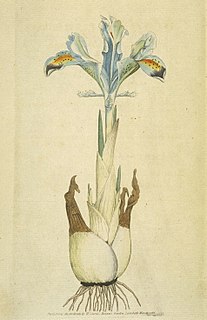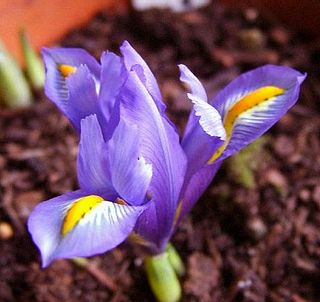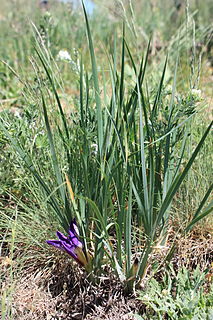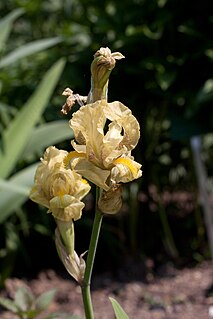
Iris subg. Scorpiris, commonly called Juno, is a subgenus of Iris, representing the smooth-bulbed bulbous irises. For a while it was an independent genus Juno Tratt. in some classifications.

Thalictrum flavum, known by the common names common meadow-rue, and yellow meadow-rue, is a flowering plant species in the family Ranunculaceae. It is a native to Caucasus and Russia (Siberia). Growing to 100 cm (39 in) tall by 45 cm (18 in) broad, it is an herbaceous perennial producing clusters of fluffy yellow fragrant flowers in summer.

Iris hyrcana, the Hyrcana iris, is a plant species in the genus Iris, it is classified in the subgenus Hermodactyloides and section Reticulatae. It is a bulbous perennial from central Asia, from Azerbaijan to Iran.

Iris caucasica is a species of plant in the genus Iris, it is also in the subgenus of Scorpiris. Pronounced as 'kaw-KAS-ee-kuh'.

Iris tubergeniana is a species in the genus Iris, it is also in the subgenus Scorpiris. It is a bulbous perennial from Central Asia, in the former states of USSR. It has pale green, pointed or sickle shaped leaves, short flowering stem holding 1-3 spring flowers in shades of yellow.

Iris pontica is a species in the genus Iris, it is also in the subgenus Limniris and in series Spuriae. It is a dwarf rhizomatous perennial plant from eastern Europe, the Causcasus region and Russia, with a short stem and violet-blue and white flowers. It is cultivated as an ornamental plant in temperate regions.
Iris spuria subsp. musulmanica is a species of the genus Iris, part of a subgenus known as Limniris and in the series Spuriae. It is a subspecies of Iris spuria and is a rhizomatous perennial plant, from Armenia, Azerbaijan, Iran and Turkey in Asia with flowers in various shades of blue, but there are rare white forms. They have a yellow centre and darker veining. It has the common name of 'Muslim iris'. It is cultivated as an ornamental plant in temperate regions.
Iris falcifolia is a plant species in the genus Iris, it is also in the subgenus Iris and in the section Hexapogon. It is a rhizomatous perennial, from Uzbekistan, Kazakhstan, Afghanistan, Iran and Pakistan. It is a small plant, with sickle-shaped greyish-green leaves, lilac-violet flowers and darker veining, and a white or yellow beard. It is cultivated as an ornamental plant in dry, temperate regions.
Iris alexeenkoi is a plant species in the genus Iris, it is also in the subgenus Iris. It is a rhizomatous perennial, from the Caucasus mountains in Azerbaijan. It has green or greyish grass-like leaves, a short slender stem and 1–2 flowers that come in shades of purple, violet, purple-blue, or blue. It is closely related to Iris pumila. It is rarely cultivated as an ornamental plant in temperate regions.

Iris imbricata is a species in the genus Iris, it is also in the subgenus Iris. It is a rhizomatous perennial, from the Caucasus mountains, within Iran, Armenia, Azerbaijan and Georgia. It has broad, sword-like, yellow green or light green leaves, slender stem with branches, inflated and overlapping green spathes, and 2–5 yellow, pale yellow or greenish yellow flowers.

Iris junonia is a plant species in the genus Iris, it is also in the subgenus Iris. It is a rhizomatous perennial, from Cilicia, within the Taurus Mountains. It has glaucous short leaves, tall stems with several branches, numerous flowers in various colours from blue-purple, lavender, pale blue, cream, white and yellow, with brown veining and white tipped orange beards. It is cultivated as an ornamental plant in temperate regions. Its status is still unclear, if it is a synonym of Iris germanica or a separate species.
Iris purpureobractea is a plant species in the genus Iris, it is also in the subgenus Iris. It is a rhizomatous perennial, from the cliffs and forest glades on the mountains of Turkey. It has straight or falcate shaped leaves, stem with several branches, the stem has purple spathes, it has up to 8 fragrant flowers, in various colours between yellow or blue. It is cultivated as an ornamental plant in temperate regions.
Iris schachtii is a plant species in the genus Iris, it is also in the subgenus Iris. It is a rhizomatous perennial, from central Anatolia, in Turkey. It has small, thin grey-green leaves, a short stem with 1–3 branches, which are normally, covered with a green leaf with purple staining. It has 2 or more fragrant flowers in late spring, which come in shades of yellow or purple, or violet and yellow,. It has a yellow or white with yellow-tips beard. It is cultivated as an ornamental plant in temperate regions, but prefers regions with dry, hot summers.
Iris taochia is a plant species in the genus Iris, it is also in the subgenus Iris. It is a rhizomatous perennial, from the Caucasus mountains and Turkey. It forms dense clumps, with grey-green leaves, simple stems of similar height, with 1–3 branches, a flowers in various shades from white, yellow to purple. They also have yellowish or white, tipped yellow beard. It is cultivated as an ornamental plant in temperate regions.

Iris acutiloba subsp. lineolata is a species in the genus Iris, it is also in the subgenus of Iris. It is a subspecies of Iris acutiloba, and is a rhizomatous perennial, from the mountains of Iran, Turkey, Turkmenistan, Tajikistan and Azerbaijan. It has narrow, lanceolate, or falcate (sickle-shaped) leaves, which are grey-green and glaucous. It has a slender straight stem holding one terminal flower. The flowers, come in shades of white, cream, or creamy white and have veining that is purple or brown, or a mixture of both. It is heavily veined or streaked in purple or brown, with a dark purple-brown, spot on 3 of the outer petals and brown, dark purple, or black short beard. It is rarely cultivated as an ornamental plant in temperate regions, unless grown in a greenhouse.

Iris acutiloba is a species in the genus Iris, it is also in the subgenus of Iris and section Oncocyclus. It is a rhizomatous perennial, from the mountains of the Caucasus and found in Turkey, Armenia, Azerbaijan, Turkmenistan, Dagestan in the North Caucasus, and Iran. It is a dwarf species, with narrow, falcate or curved leaves, it has one flower in spring or early summer, that comes in shades from cream, creamy white, whitish, pale brown, light grey, to pale violet. It is heavily veined or streaked and pointed, with 2 dark spots and brown, purple, dark purple, or black short beard. It is cultivated as an ornamental plant in temperate regions. There are two subspecies, Iris acutiloba subsp. lineolata and Iris acutiloba subsp. longitepala.
Iris barnumiae is a species in the genus Iris; it is also in the subgenus Iris and in the section Oncocyclus. It is a rhizomatous perennial, from Armenia, Azerbaijan, Iran, Iraq, and Turkey. It has pale glaucous green and narrow leaves, that are slightly sickle-shaped and fade soon after blooming. It has, in mid- to late spring, fragrant flowers in shades of purple, from red-purple, mulberry to purplish-violet, with a yellow tipped with purple beard. It was renamed as I. barnumiae in after a plant naming conference in 2011, but is still sometimes named as I. barnumae in some sources. It has one accepted subspecies Iris barnumiae subsp. demawendica and two forms; Iris barnumiae f. protonyma (Stapf) B.Mathew & Wendelbo and Iris barnumiae f. urmiensis (Hoog) B.Mathew & Wendelbo, which has yellow flowers. Sometimes I. barnumiae f. barnumiae is used to describe the basic form. It is rarely cultivated as an ornamental plant in temperate regions, due to its needing very dry and warm summer conditions.
Iris camillae is a species in the genus Iris, it is also in the subgenus Iris and in the section Oncocyclus. It is a rhizomatous perennial, from Azerbaijan. It has narrow, falcate (sickle-shaped) leaves, medium-sized stem and large flowers, where the flower colour is very variable, ranging from violet, purple, pale blue, and also yellow, and occasionally bi-colour forms are found. It has a yellow beard. It is rarely cultivated as an ornamental plant in temperate regions, due to its environmental conditions of its natural habitat.
Iris grossheimii is a plant species in the genus Iris, subgenus Iris and section Oncocyclus. It is a rhizomatous perennial, from the Caucasus mountains of Georgia, Armenia and Azerbaijan. It has sickle shaped leaves, which are as long as the short stem, which carries one flower in spring. It is beige, pink or brown covered in dark lines that are, purple-brown or brown. It has a large blackish brown signal patch and brown or black beard. It is rarely cultivated as an ornamental plant in temperate regions, as it needs very dry conditions during the summer.

Iris iberica subsp. elegantissima is a subspecies in the genus Iris, subgenus Iris and section Oncocyclus. It is a subspecies of Iris iberica and is a rhizomatous perennial, from Armenia, Turkey and Iran. It has large, thin and falcate (sickle-shaped) leaves, slender stem with a single flower between April and May. It has a white, cream or pale yellow ground, which is covered in dark veining or speckling in violet, mauve, purple or brown shades. The larger standards are paler, normally white and less veined. The falls, have darker veining and a dark signal patch and brown or purple beard. It is commonly known as Iris elegantissima, especially in Europe and Russia. It is cultivated as an ornamental plant in temperate regions, but normally needs some protection during the winter period.











